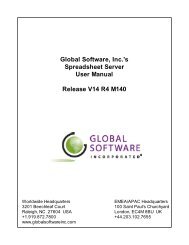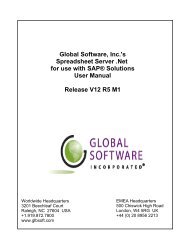Spreadsheet Server for use with Lawson - Global Software, Inc.
Spreadsheet Server for use with Lawson - Global Software, Inc.
Spreadsheet Server for use with Lawson - Global Software, Inc.
Create successful ePaper yourself
Turn your PDF publications into a flip-book with our unique Google optimized e-Paper software.
73<br />
<strong>Spreadsheet</strong> <strong>Server</strong> <strong>for</strong> <strong>use</strong> <strong>with</strong> <strong>Lawson</strong> - Release V12 R5 M1<br />
Field Description Example<br />
Source Worksheet<br />
Target Worksheet<br />
Source Detail Row<br />
Target Table,<br />
Range, or Row<br />
Headings<br />
Autofit<br />
Clear Sheet<br />
Identify the name of the worksheet that contains the summary<br />
<strong>for</strong>mulas that will be expanded.<br />
Identify the name of the worksheet that contains the final <strong>for</strong>matted<br />
worksheet and will receive the expanded detail.<br />
Identify the row number in the source worksheet that contains the<br />
summary <strong>for</strong>mulas.<br />
Identify the target table or range name on the target worksheet to<br />
begin inserting the expanded detail.<br />
Note: When using a target range, identify the Excel range as all<br />
cells under the columns headers. In the example, Range4 is <strong>for</strong><br />
cells A5 thru H5, Range5 is <strong>for</strong> cells A11 thru H11, and Range6 is<br />
<strong>for</strong> cells A17 thru H17.<br />
Enter Y or N to indicate whether or not to include column headings<br />
when expanding details. If not specified, N (No) is assumed.<br />
Enter Y or N to indicate whether or not to autofit columns when<br />
expanding details. If not specified, N (No) is assumed.<br />
Enter Y or N to indicate whether or not to clear the target worksheet<br />
be<strong>for</strong>e expanding details. If not specified, N (No) is assumed.<br />
Note: This value MUST be N when a TABLE or RANGE is specified<br />
<strong>for</strong> the Target Table/Range/Row parameter.<br />
Not applicable when using the GXE to expand account detail.<br />
GXE Multiple<br />
Source<br />
GXE Multiple<br />
Target<br />
16<br />
17<br />
18<br />
Range4<br />
Range5<br />
Range6<br />
Journals Only<br />
(leave blank)<br />
Column<br />
Starting Column Identify the starting column <strong>for</strong> the template. A<br />
Starting Row Identify the starting row <strong>for</strong> the template. 20<br />
N<br />
N<br />
N<br />
3. After the GXE data has been entered and verified, click the Insert icon or button. The parameters and GXE<br />
<strong>for</strong>mula are inserted to the selected worksheet (see the sample spreadsheet above).<br />
Formula Example:<br />
=GXE(B21,B20,B23,B22,B24,B25,B26,B27)<br />
=GXE(B21,B20,C23,C22,B24,B25,B26,B27)<br />
=GXE(B21,B20,D23,D22,B24,B25,B26,B27)<br />
4. Format the Target Worksheet <strong>with</strong> headings in rows 1-3, 9 and 15, blank rows in rows 4-6, 10-12 and 16-18<br />
and totals in row 7, 13 and 19. Set each total to a range of rows 4-6, 10-12 or 16-18 (i.e. cell A7 is<br />
=SUM(A4:A6)). When the Expand Detail Reports function is initiated, the total lines are shifted down or up,<br />
based upon the number of data rows populated each time the expansion is processed.
















